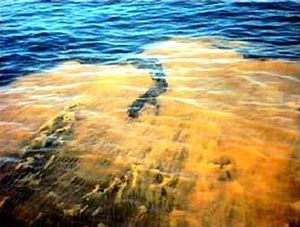About six years ago I went to a wedding on the Gulf of Mexico which was extraordinary except for the occurrence of red tide. Don’t get me wrong, the guests and bride and groom all had a fabulous time despite the red tide. How did it affect us? We were not permitted to swim in the ocean and made the best out of it by playing run the bases on the beach. We could only do this for a little while since it actually affected our breathing and so we took a lot of breaks for margaritas.
It got me wondering what is a red tide? From my research it seems that red tides are not always red and have nothing to do with tides. Scientists are trying to wash away the term red tide and use the term harmful algae bloom (HAB) which explains a bit better about what happens during these occurrences. During a HAB on the Gulf of Mexico there is a high concentration of microscopic marine algae known as Karenia brevis. This is not the only algal culprit to an HAB, but, it is the most frequent. In the Gulf of Mexico the algae Alexandrium fundyense has been known to cause serious damage to local fisheries. In low concentrations these algae is not harmful. But, with high concentrations fish suffocate after it paralyzes their central nervous system. Also, many shellfish that filter water can accumulate the toxins and become inedible to eat.
How harmful algal blooms occur is still under debate. It can be a natural or man-made occurrence.
Do you have another great question? Email info@beachchairscientist.com and let me know what you always ponder while digging your toes in the sand!








What people are saying …